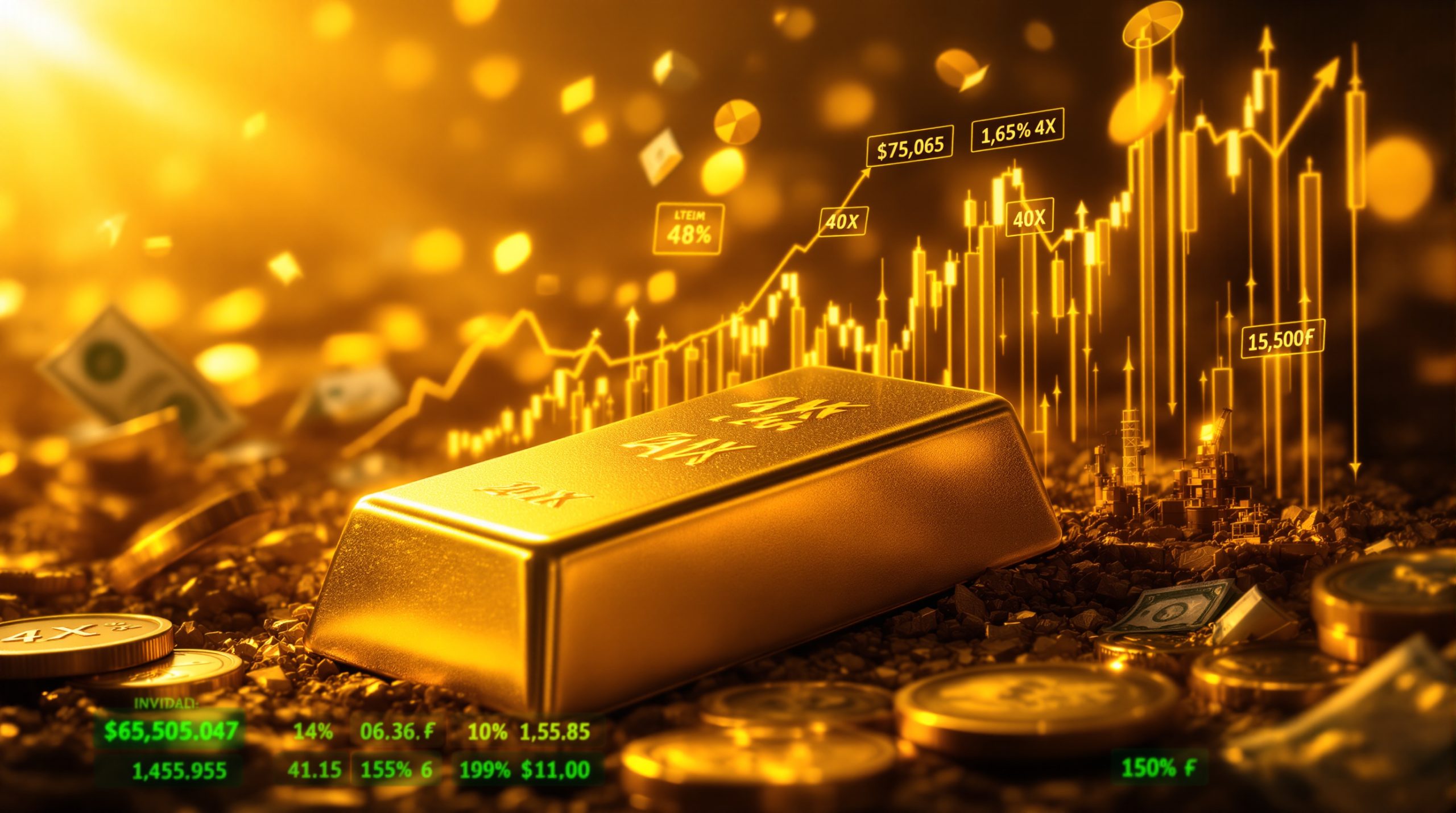What's Driving the Recent Silver Price Rally?
Silver has entered a transformative phase in the market, with prices establishing a new trading range around $35-36 per ounce. Market experts increasingly view this as a paradigm shift rather than a temporary price spike, with strong support at the $30 level and potential to reach $40 per ounce in the near term.
This price strength represents a fundamental revaluation of silver's prospects rather than just technical trading patterns. While the market has historically paid close attention to the gold-silver ratio insights, veteran industry professionals emphasize that this ratio is a lagging indicator calculated after price movements occur, not a predictive tool.
"We've entered a new paradigm where prices are unlikely to trade below $30 and more likely to touch $40. This isn't just about ratios; it's a fundamental shift in how the market views silver's supply-demand outlook," explains Juan Shaver, President of Silvercorp Metals.
The New Silver Price Paradigm
The current price environment creates exceptional profit opportunities for established silver producers with efficient operations. Companies with all-in sustaining costs (AISC) around $12 per ounce—like Silvercorp Metals—are generating margins exceeding $20 per ounce, a dramatic improvement from historical norms.
These expanded margins provide established producers with substantial cash flow to fund growth initiatives, whether through exploration, development, or strategic acquisitions. Companies that maintained operational discipline during lower price environments are now positioned to capitalize on this windfall without compromising their long-term business models.
Supply-Demand Fundamentals vs. Gold-Silver Ratio
Market veterans caution investors against over-reliance on the gold-silver ratio as a trading signal. While this ratio (historically averaging 60:1) provides context, fundamental supply-demand dynamics offer more reliable insights into silver's price trajectory.
Key fundamental factors supporting current prices include:
- Limited new mine supply coming online despite higher prices
- Growing industrial demand from green technology sectors
- Renewed investment interest amid economic uncertainty
- Production constraints from years of underinvestment in exploration
Unlike the gold-silver ratio, which can remain "out of whack" for extended periods, these fundamental drivers provide structural support for the current price range.
Production Costs and Profit Margins
The economics of silver mining have transformed dramatically at current price levels. Companies with established operations and controlled costs are experiencing unprecedented profit margins:
| Production Cost Category | Industry Average | Low-Cost Producer | Current Silver Price | Margin (Low-Cost) |
|---|---|---|---|---|
| Cash Cost (per oz) | $10-15 | $5-8 | $35-36 | $27-31 |
| All-in Sustaining Cost | $15-22 | $10-14 | $35-36 | $21-26 |
| All-in Cost | $18-25 | $12-16 | $35-36 | $19-24 |
This margin expansion allows disciplined producers to build substantial cash reserves even while funding ambitious growth plans—a rare combination in the historically volatile silver market.
How Are Global Trade Policies Affecting the Silver Market?
Recent shifts in global trade policy have created both disruptions and opportunities across metal markets, with indirect effects on silver pricing and producer strategies. While silver itself hasn't been the primary target of new trade barriers, the interconnected nature of metals markets means these policies still influence the broader landscape.
Impact of Tariffs on Metal Markets
May 2025 saw the implementation of significant tariffs on metals like copper, reaching as high as 50% in some jurisdictions. These measures primarily target specific countries and metals, but their effects ripple through global supply chains and commodity markets.
"Tariffs disrupt specific markets but don't override global pricing. If you produce silver in Peru or China, you're still getting the London fix. Domestic processing gaps also undermine tariff goals—concentrates shipped offshore for refining defeat 'supply chain security'," notes Juan Shaver.
For silver producers, these policies create a complex operating environment where trade flows may shift, but global price mechanisms remain dominant. The uneven application of tariffs impact analysis across metals and jurisdictions adds another layer of complexity for polymetallic producers whose revenue streams include both tariffed and non-tariffed metals.
Domestic Processing Capabilities
A critical weakness in metal-focused trade policies lies in downstream processing capacity gaps. Many mining operations produce concentrates requiring sophisticated processing facilities before becoming usable in manufacturing—facilities that often don't exist domestically in the countries implementing tariffs.
This processing bottleneck means that despite tariff barriers:
- Concentrates still flow to international processing hubs
- Supply chain security objectives remain unfulfilled
- Price impacts are moderated by processing workarounds
- Domestic miners gain limited protection without domestic processing options
Without concurrent investment in smelting and refining capacity, tariffs often fail to achieve their stated supply chain resilience goals, particularly for technically complex metals like silver.
Global Price Mechanisms
For silver producers, the global price discovery mechanism remains the primary determinant of profitability, regardless of operational jurisdiction. Silver is priced in international markets, with producers typically receiving the global benchmark price minus relevant treatment charges and transportation costs.
This global pricing reality means that while tariffs may affect regional metal flows, they rarely alter the fundamental economics of silver production. Producers focus on operational efficiency and cost control rather than attempting to capitalize on trade policy shifts that may prove temporary or ineffective.
What's Happening with Silver Industry Consolidation?
The silver sector has experienced a notable wave of consolidation over the past 12-18 months, signaling confidence in silver's long-term prospects. However, these transactions haven't materially increased production capacity—they've primarily redistributed existing assets among fewer corporate entities.
Recent Merger Activity
Merger and acquisition activity has accelerated significantly as companies seek scale advantages and operational synergies. Notable transactions have involved both major producers absorbing smaller competitors and strategic combinations of mid-tier operators seeking critical mass.
These transactions typically fall into several categories:
- Scale-focused combinations between similar-sized producers
- Capability acquisitions where buyers seek specific technical expertise
- Portfolio diversification into adjacent metals or jurisdictions
- Distressed acquisitions of financially challenged operators
While these transactions signal industry optimism, they don't address the fundamental challenge of limited new silver supply entering the market. The overall production profile remains largely unchanged despite the shuffling of corporate ownership.
Limited Project Pipeline
Industry insiders consistently describe the development pipeline for new silver projects as "skinny" relative to market needs. Few high-quality, undeveloped silver assets exist globally, and those that do often command premium valuations that challenge acquisition economics.
"Mergers signal confidence but don't add new ounces. The pipeline is thin—premier assets command impossible premiums. Companies like Silver Standard proved you must build to create value," explains Juan Shaver.
The project scarcity reflects several long-term industry challenges:
- Years of underinvestment in silver-focused exploration
- Geological reality that few deposits have economic silver grades
- Technical complexity of developing high-quality silver assets
- Permitting and social license hurdles for new mine development
This limited pipeline supports the thesis that silver supply will remain constrained even as prices incentivize production growth.
Development vs. Acquisition Economics
The premium required to purchase development-stage silver assets has created a situation where companies increasingly need to develop projects organically rather than acquiring them. The acquisition premium—often exceeding 30% for quality assets—frequently eliminates the economic rationale for purchases versus self-funded development.
Many successful silver companies have proven the value of this build-to-sell model:
- Identify and acquire promising early-stage assets
- Fund development through existing cash flow
- De-risk through phased development and technical studies
- Operate initially to demonstrate economic viability
- Sell or joint venture once production validates the asset value
This approach typically generates substantially higher returns than paying premium prices for partially developed assets, particularly in the current environment of limited high-quality projects.
What Are the Industrial and Investment Drivers for Silver?
Silver's market dynamics benefit from its unique position as both an industrial metal and an investment asset. This dual demand profile creates multiple potential catalysts for price appreciation and helps moderate downside volatility during economic cycles.
Dual Nature of Silver Demand
Unlike gold, which derives most of its value from investment and monetary applications, silver maintains a robust industrial demand base alongside its precious metal characteristics. This creates a distinctive market profile:
| Demand Category | Approximate Share | Primary Growth Drivers | Price Sensitivity |
|---|---|---|---|
| Industrial | 50-60% | Technology adoption, green energy | Moderate |
| Investment | 25-30% | Monetary concerns, inflation hedging | High |
| Jewelry/Silverware | 15-20% | Consumer discretionary spending | Moderate |
| Photography | <5% | Specialized applications | Low |
"Silver's dual nature is its superpower. Electrification needs it for conductivity, and investors see it as gold's leveraged play. When Chinese consumers rushed gold, they bought silver too—that's new," notes Juan Shaver.
This balanced demand profile helps stabilize the market through economic cycles—when industrial demand weakens during recessions, investment demand often strengthens as monetary concerns increase.
Electrification and Green Energy Trends
Silver's industrial applications continue expanding with the global electrification trend and renewable energy deployment. The metal's unique properties—including the highest electrical conductivity of any element—make it essential for high-performance electronic applications.
Key growth sectors include:
- Solar photovoltaics: Using approximately 100 million ounces annually (15% of total demand)
- Electric vehicles: Requiring 20-30 grams per vehicle in high-reliability electronics
- 5G infrastructure: Using silver in transmitters, receivers, and network components
- IoT devices: Incorporating silver in miniaturized electronics and sensors
As societies transition toward renewable energy and transportation electrification, these applications represent structural growth drivers for silver demand that operate independently of its investment characteristics.
Physical Silver Purchasing Trends
Market observers note increasing consumer interest in physical silver ownership, particularly in markets like China where retail investment patterns often foreshadow broader trends. This mirrors similar movements in gold markets, where central banks and private investors have substantially increased physical holdings over recent years.
Recent reports from dealers and exchanges indicate:
- Retail coin premiums rising above historical averages
- Mint production capacity struggling to meet demand spikes
- ETF inflows accelerating after years of outflows
- Chinese consumer buying expanding beyond traditional gold preference
These physical market indicators suggest strengthening investment demand alongside industrial consumption, creating potential for continued price support.
How Are Silver Mining Companies Navigating Current Market Conditions?
Established silver producers are leveraging the current price strength to position themselves for sustainable long-term growth while addressing historical challenges in the sector. Their strategies reveal both the opportunities and constraints facing the industry.
Operational Focus During Price Strength
Leading silver producers with proven operational track records are pursuing multiple strategic objectives during this period of strong pricing:
- Building cash reserves to weather future market volatility
- Funding organic growth through brownfield expansion
- Developing new projects from their exploration pipeline
- Pursuing strategic acquisitions in complementary metals
- Strengthening balance sheets by reducing debt burdens
This disciplined approach contrasts with previous price cycles where companies often pursued aggressive but ultimately unsustainable expansion. Today's producers are generally maintaining cost discipline while selectively investing in high-return opportunities.
Jurisdictional Diversification
Silver producers increasingly emphasize jurisdictional diversification to mitigate political and regulatory risks. While certain regions like Mexico have experienced permitting challenges in recent years, companies report incremental improvements in some regulatory environments.
"We're using cash from $35 silver to build new mines and diversify. Mexico's permitting improved, but Ecuador is our bet—its government just greenlit a peer's project, proving mining policy works," shares Juan Shaver.
This jurisdictional strategy involves:
- Portfolio balancing across multiple countries and regulatory regimes
- Risk-adjusted investment accounting for jurisdiction stability
- Relationship building with host communities and governments
- Selective entry into emerging mining jurisdictions with improving frameworks
Companies increasingly view political risk as manageable through diversification rather than avoiding certain regions entirely, though they typically demand higher return thresholds for higher-risk jurisdictions.
Growth Beyond Silver
Many traditional silver producers are expanding into gold, copper, and polymetallic projects to diversify their portfolios. This strategy helps mitigate silver's historical silver performance volatility while maintaining exposure to its current upside potential.
This diversification approach includes:
- Developing gold-silver projects where silver represents one of multiple revenue streams
- Acquiring copper assets to capture electrification trends through multiple metals
- Pursuing polymetallic deposits with silver as a significant but not dominant component
- Leveraging technical expertise across similar mining methods regardless of primary metal
The result is an evolving industry where few "pure play" silver producers remain, with most companies maintaining silver exposure within a more balanced portfolio of metals.
What Challenges Face the Silver Mining Sector?
Despite favorable pricing, the silver mining sector confronts persistent challenges that constrain supply growth and complicate development efforts. These structural issues help explain why production hasn't responded more robustly to higher prices.
Permitting and Social License
Obtaining permits and maintaining social license to operate remain formidable challenges for mining projects globally. Even with compelling economics supported by higher metal prices, these non-technical factors often determine whether projects advance to production.
"Higher prices fix spreadsheets but not rocks. If your ore body is marginal, $40 silver won't save you. And without permits, you have nothing—money can't buy social license," cautions Juan Shaver.
Recent industry experience suggests:
- 70% of projects face permitting delays exceeding 2 years
- Community opposition increasingly affects projects even in mining-friendly jurisdictions
- Regulatory requirements continue expanding in scope and complexity
- Social media amplifies local concerns to global audiences, increasing pressure
These challenges explain why even economically attractive projects often stall for years despite robust economics and capable management teams. No amount of capital can overcome these hurdles without patient, consistent stakeholder engagement.
Technical Project Quality
Higher silver prices improve project economics but don't resolve fundamental technical challenges. Industry experts caution that while rising prices may attract funding to marginal projects, technical merit remains essential for long-term operational success.
Critical technical factors include:
- Ore grade and consistency affecting processing recoveries
- Metallurgical complexity determining processing costs and recoveries
- Geotechnical conditions influencing mining methods and costs
- Water management requirements constraining operations in many regions
- Infrastructure access affecting capital intensity and timeline
Projects lacking favorable characteristics in these areas rarely succeed even with strong metal prices. The industry has learned painful lessons from previous cycles where marginal projects funded during price peaks failed when prices normalized.
Exploration and Development Pipeline
The limited pipeline of new silver projects represents a structural challenge for the industry. Years of underinvestment in exploration, combined with the difficulty of finding economic silver deposits, has created a situation where few new mines are under development despite strong prices.
Industry experts highlight several contributing factors:
- Exploration budgets slashed during previous downturns haven't fully recovered
- Junior explorers struggle to access capital even in improved market conditions
- Technical talent shortages limit capacity to evaluate and advance prospects
- Risk capital preferences shifted toward battery metals and other commodities
This exploration deficit means that even with today's strong prices, significant new silver supply may take 5-10 years to materialize, supporting the thesis of sustained higher prices in the medium term.
How Does the Paper Silver Market Interact with Physical Supply?
The relationship between paper silver markets (futures, ETFs) and physical metal supply creates both opportunities and challenges for market participants. Understanding these dynamics provides important context for silver's price behavior.
Market Efficiency Perspectives
Industry participants generally view the paper silver market as a natural component of price discovery, despite occasional criticisms about its relationship to physical metal. Most producers accept this market dynamic as a long-established feature of the precious metals landscape.
"Paper markets aren't the enemy. Everyone knows the disconnect exists—it's been there 20 years. But when physical tightness hits, like uranium's breakout, fundamentals win," observes Juan Shaver.
Professional market participants recognize several key realities:
- Paper markets provide essential liquidity for hedging and price discovery
- ETFs create accessible investment vehicles that broaden market participation
- Futures markets facilitate efficient price discovery despite occasional disconnects
- Physical delivery mechanisms ensure ultimate connection to tangible supply
These mechanisms generally function efficiently during normal market conditions, though periods of extreme stress can temporarily create disconnects between paper and physical prices.
Physical vs. Paper Market Dynamics
While some market observers express concerns about disconnects between paper and physical silver markets, producers typically focus on operational excellence rather than market structure debates. Historical precedent from other metals markets suggests that physical fundamentals eventually overcome paper market dynamics when supply-demand imbalances become significant.
Notable examples include:
- Uranium's 2021-2023 breakout: Physical supply shortfalls eventually overcame paper positioning
- Palladium's 2018-2020 surge: Industrial demand overwhelmed paper market resistance
- Nickel's 2022 short squeeze: Physical tightness triggered unprecedented market disruption
These cases demonstrate that while paper markets may temporarily mask physical reality, fundamental supply-demand dynamics ultimately assert themselves—sometimes dramatically through a [silver market squeeze](https://discov
Ready to Stay Ahead of the Next Major Silver Discovery?
Stay informed about significant mineral discoveries across all commodities, including silver, with Discovery Alert's proprietary Discovery IQ model that delivers real-time notifications of actionable opportunities on the ASX. Visit our discoveries page to understand how early identification of major mineral discoveries can lead to substantial investment returns.




